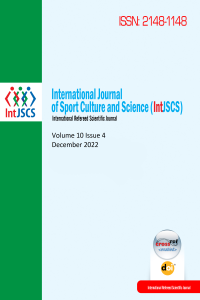Öz
Kaynakça
- Dökmen, Ü. (2003). Sociometry and Psychodrama. Sistem Publishing Fourth Edition.
- Lupu,S. G. (2013). TheSociometricTechnıquesandTheirImplementation in the Athletic Performance Activity. SpSocInt J Ph Ed Sp, 13:137-140.
- Martin L. J., Balderson D., Hawkins M., Wilson K.,& Bruner M. W. (2017). GroupnessAndLeadershipPerceptions İn RelationToSocialİdentity İn YouthSport.Journal of AppliedSport Psychology, 29(3), 367-374.
- Milenko, V. M.,&Jovanović, M. (2014). Sociometric Structure of Premier League Volleyball Club. SportLogia. 10(2), 96–105.doi: 10.5550/sgia.141002.en.006V.
- Moreno, J. L. (Ed.), (1961), ThesociometryReader (Translator: Kösemihal N). New York, NY, US: Free Press.
- Romadhoni, WN., Nasuka, N.,&Priambodo, E.N. (2020). Sociometry of a Women Handball Team. İSPHE, 596-602.DOI 10.41082300324.
- Sabin, S. I., & Marcel, P. (2015), Improving Performance of a Basketball Team (10-12 years) Through Developing Cohesion of the Sport Group. Ovidius University Annals, Series Physical Education and Sport/Science, Movement and Health, 15(2 S1), 534-541.
- Sopa, I. S., &Pomohaci, M. (2018), Discovering the leader of a volleyball team using the sociometric survey method. Timisoara Physical Education & Rehabilitation Journal, 10(3).
- Şatıroğlu, A. (1999). On Moreno and Sociometry. Istanbul University Journal of Sociology, 3;5: 111 – 126.
- Şirin, M. (1993). The Role of Sociometry in the Analysis of Natural Groups. Master Thesis, Institute of Social Sciences, Uludağ University, Bursa.
- Vıktorovna, V.I., Vladımırovna, V.T.,&Nıkolaevna S.N. (2019). Sociometry of a Volleyball Team. Journal of Physical Education and Sport. Vol.19 (issue 2), Art 160, pp. 1104 - 1111, 2019 DOI:10.7752/jpes.2019.02160.
Öz
Sociometry is a measurement method used to determine the social structure of a particular group, its harmony within itself, the social development of group members, and their place in the group. In team sports, it is necessary to solve the problems between individuals to ensure harmony within the group during the competition preparation process. For this reason, it is significant to use sociometry studies in sports environments. The aim of this study is to learn the characteristics of the selected group and the relationships between team players. The methodology of the study is based on the sociometric method of structural analysis of small groups. The study group consists of Ziraat Bank's star men's volleyball team, which became the champion of Turkey in the 2018-2019 season in the men's star category. The data collection tool consists of 3 questions prepared by scanning similar studies and taking expert opinions. While preparing the questions, the questions were ensured to serve the purpose of sociometry. Considering the results of the study, we can say that on the basis of the players' positions, each player prefers players in a position other than their own. Therefore, they are aware of the need for each other for success. In addition, according to the results of the analysis of the data, the fact that the first choice of the people we see at the center of our sociogram in difficult tasks is those who are not preferred by the social person, which shows us the result that success is not a coincidence, but a professional point of view.
Anahtar Kelimeler
Kaynakça
- Dökmen, Ü. (2003). Sociometry and Psychodrama. Sistem Publishing Fourth Edition.
- Lupu,S. G. (2013). TheSociometricTechnıquesandTheirImplementation in the Athletic Performance Activity. SpSocInt J Ph Ed Sp, 13:137-140.
- Martin L. J., Balderson D., Hawkins M., Wilson K.,& Bruner M. W. (2017). GroupnessAndLeadershipPerceptions İn RelationToSocialİdentity İn YouthSport.Journal of AppliedSport Psychology, 29(3), 367-374.
- Milenko, V. M.,&Jovanović, M. (2014). Sociometric Structure of Premier League Volleyball Club. SportLogia. 10(2), 96–105.doi: 10.5550/sgia.141002.en.006V.
- Moreno, J. L. (Ed.), (1961), ThesociometryReader (Translator: Kösemihal N). New York, NY, US: Free Press.
- Romadhoni, WN., Nasuka, N.,&Priambodo, E.N. (2020). Sociometry of a Women Handball Team. İSPHE, 596-602.DOI 10.41082300324.
- Sabin, S. I., & Marcel, P. (2015), Improving Performance of a Basketball Team (10-12 years) Through Developing Cohesion of the Sport Group. Ovidius University Annals, Series Physical Education and Sport/Science, Movement and Health, 15(2 S1), 534-541.
- Sopa, I. S., &Pomohaci, M. (2018), Discovering the leader of a volleyball team using the sociometric survey method. Timisoara Physical Education & Rehabilitation Journal, 10(3).
- Şatıroğlu, A. (1999). On Moreno and Sociometry. Istanbul University Journal of Sociology, 3;5: 111 – 126.
- Şirin, M. (1993). The Role of Sociometry in the Analysis of Natural Groups. Master Thesis, Institute of Social Sciences, Uludağ University, Bursa.
- Vıktorovna, V.I., Vladımırovna, V.T.,&Nıkolaevna S.N. (2019). Sociometry of a Volleyball Team. Journal of Physical Education and Sport. Vol.19 (issue 2), Art 160, pp. 1104 - 1111, 2019 DOI:10.7752/jpes.2019.02160.
Ayrıntılar
| Birincil Dil | İngilizce |
|---|---|
| Konular | Spor Hekimliği |
| Bölüm | Makaleler |
| Yazarlar | |
| Yayımlanma Tarihi | 31 Aralık 2022 |
| Yayımlandığı Sayı | Yıl 2022 Cilt: 10 Sayı: 4 |


